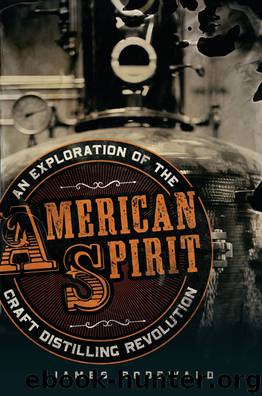American Spirit by James Rodewald

Author:James Rodewald
Language: eng
Format: epub
Publisher: Sterling Epicure
From left to right: Jörg Rupf, founder; Lance Winters, owner and master distiller; and Dave Smith, assistant distiller at St. George Spirits.
The most unusual flavor in the Terroir Gin comes from Douglas fir, but there’s also bay laurel, coastal sage, fennel, wok-roasted coriander, cinnamon, orris root, and citrus peel in addition to the requisite juniper. It’s very citrusy, which Winters says is in part a result of the bay laurel pushing the citrus elements forward. What I find most striking about all three St. George gins is the mouthfeel. My assumption was that the distillery might be using a particularly good grain neutral spirit, but Winters says that’s not what I was experiencing. “It’s the amount of botanicals. The spirit we use for the gins, the job for that is to be a neutral canvas. It’s the oils from all the botanicals that provide that richness, that roundness. We do a light filtration, some other people might do a heavier filtration, and they might do a little cold filtration, and that’s going to strip a lot of those oils out as well.”
Botanivore has an astounding nineteen different botanicals, most of which are steeped in the grain neutral spirit overnight. Despite the intensity of flavor, it still somehow maintains an elegance that I suspect will appeal to longtime gin drinkers. The third is barely a gin at all. Dry Rye is round, sweet, and somewhat peppery. All three are bottled at high proof—45 percent alcohol—with mixing in mind, and the Dry Rye combined with a good sweet vermouth and Campari makes a killer Negroni. If Winters ever gets the amaro he’s been working on to the market, I want to be the first in line to try it and the Dry Rye in that classic cocktail.
There are very few craft distillers even playing with amari, and I’ve asked a lot of them about it. They’re extremely popular in Italy, of course, and in this country in recent years one brand, Fernet Branca, has become what is often called a secret handshake for bartenders and patrons. Leopold Brothers, a Denver-based producer of excellent fruit liqueurs and some other interesting spirits, makes a Fernet that’s quite good, but that’s about it for Amari made in the United States. Winters has a theory about why amaro isn’t a big seller here. “I think it’s for the same reason that people were hard to get into things like absinthe: we don’t like licorice, and we don’t like bitter. The reason that bitters work to stimulate your digestive process is because you’re tricking your body into thinking it’s poison. I loooove bitter. Our first stab at an amaro, we took grain alcohol and distilled that through rosemary and juniper and bay laurel. Into that we infused Seville orange peel, chinchona, wormwood, gentian, turkey rhubarb, white turmeric, cinnamon, lavender, orris root, and cola nut. I wanted to get something put together to figure out where I need to start shifting some of the flavors. I’ve got a pretty good idea.
Download
This site does not store any files on its server. We only index and link to content provided by other sites. Please contact the content providers to delete copyright contents if any and email us, we'll remove relevant links or contents immediately.
101 Whiskies to Try Before You Die by Ian Buxton(44033)
World's Best Whiskies by Dominic Roskrow(43991)
Whiskies Galore by Ian Buxton(41530)
Craft Beer for the Homebrewer by Michael Agnew(17933)
Right Here, Right Now by Georgia Beers(3915)
Not a Diet Book by James Smith(3149)
Water by Ian Miller(2950)
The Coffee Dictionary by Maxwell Colonna-Dashwood(2937)
Kitchen confidential by Anthony Bourdain(2824)
Coffee for One by KJ Fallon(2422)
Smuggler's Cove: Exotic Cocktails, Rum, and the Cult of Tiki by Martin Cate & Rebecca Cate(2338)
Talking as Fast as I Can by Lauren Graham(2253)
Beer is proof God loves us by Charles W. Bamforth(2249)
Superfood Smoothie Bowls: Delicious, Satisfying, Protein-Packed Blends that Boost Energy and Burn Fat by Chace Daniella(2233)
Bourbon: A Savor the South Cookbook by Kathleen Purvis(2129)
A Short History of Drunkenness by Forsyth Mark(2066)
Eat With Intention by Cassandra Bodzak(2003)
Colombia Travel Guide by Lonely Planet(1942)
Cocktails for the Holidays by Editors of Imbibe magazine(1935)
